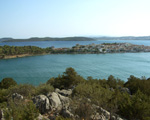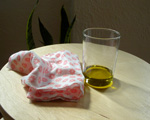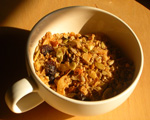September 2009
Coming Soon:
Hermes olives and olive paste! Olives for all tastes, ranging from classic Kalamata olives to Green Chalkidiki Olives stuffed with sun-dried tomatoes.
Traveling to the Source
Elaioladon-Contis Imports hopes everyone's summers were full of relaxation and good food! President Vasilios Contis checked on his own personal olive grove in Greece's Argolid region this summer.
As you start planning next year's vacations, let us recommend the special regions where our Greek olive oil and Indian pepper are produced. Each makes for an interesting travel and food destination.
Magical Mistra, Greece
Olives and olive oil have been a major part of life in the Peloponnese region of Greece for thousands of years. That's where both of our extra virgin olive oil suppliers are based.
Mistra Estates, home of the unfiltered Extra Virgin First Cold Pressed Olive Oil, are located near the UNESCO World Heritage Site of Mistra (also "Mystra"). Mistra is a small town that's only 3.7 miles from Sparta. However, in the 13th century, it was the bustling seat of the Latin Principality of Achaea, built by the Franks.
Today, travellers can visit the ruins of the palace Prince William II Villehardouin built. The archaeological site is located on a dramatic hillside, with incredible drop offs and vistas. Mistra Estates is produced in the vicinity of this magical, green place at the foothills of massive Mt. Taygetus.
Country sausage and "kayana" omelette are among the local dishes devoured at taverns near Neo Mistra town.
Seaside Ermioni, Greece
The landscape is completely different at the Peloponnese’s coastal Ermioni region, the home of Hermes - Dimarakis' Kalliston and organic Authentikon olive oils. It is located three hours from Mistras by car.
In antiquity, Ermioni relied on shipbuilding. Today it blends agriculture and seaside tourism. Kouverta, Petrothalassa and Bourloto are among popular beaches. The town's Agioi Anargiroi Monastery for women is especially busy on its July 1 feast day.
With views of nearby islands like Hydra, Ermioni has attracted tourism for decades. If fish is popular in Ermioni for obvious reasons, the nearby town of Trachea boasts bakeries and kefalotyri goat's milk cheese.
Lush Tellicherry, India
Much further away, on the southwestern coast of India, is Tellicherry Taluka (or county), where The Malabar Pepper Company's select black peppercorns are grown and processed. This region of the verdant, water-rich state of Kerala, is known for spices including pepper and cardamom. Christopher Columbus was sailing westward - to find an easier route to the Malabar Coast and its spices - when he accidentally discovered America.
In India, Kerala is known for its high literacy rate (90%) as well as its natural wonders, including beaches, canals, waterfalls and wildlife. The tourism industry is growing as the Tellicherry (or Thalaserry) region draws visitors for its temples and forts as well as natural wonders (including the current monsoons, which taper off by September).
Kerala cuisine includes both vegetarian dishes and fish and lamb dishes and stews. Locally-grown coconuts, rice and spices are vital to most meals. Columbus’ accidental voyage has had consequences in the cuisine of his original destination. Today, in addition to the black pepper, chiles (native to South America) supply fiery heat to the local cuisine. However milder authentic Malabar dishes, which use only fresh coarsely ground pepper, continue to be popular too.
Customer of the Month: Jivamuk Tea Café
Which extra virgin olive oil is served at Manhattan's hippest yoga studio? Elaioladon - Contis Imports of course. Only the highest quality olive oil will do at the Jivamuk Tea Café, located within the legendary Jivamukti Yoga School.
Salads are a popular post-workout choice for the beautiful people who frequent the popular Union Square school and its airy café. Their faces flushed from workouts, Manhattanites tuck into bowls of greens as they chat with friends or work at laptops.
Café manager Ayinde Howell explains that Elaioladon olive oil is key. He says, "We exclusively use it in our eight dressings." Maple Vinaigrette and Spicy Peanut are a few of the dressing options sprinkled over 11 different salads. There's also a container of the olive oil handy for customers to add more to their greens, at the laid-back, high-ceilinged café.
What's Jivamukti? It's a style of yoga created by the school's founders David Life and Sharon Gannon in 1984 -and endorsed by the likes of rock star/activist Sting. The Jivamukti schools are noteworthy for their blend of soul-searching and calorie-burning.
You don't have to do a headstand to eat at the café, which opened to the public a year and a half ago. The menu boasts "All vegan, all the time". Howell keeps the special options interesting. The Raw Red Soup blends apples, carrots and beets. In the Bacon Salad, the "bacon" (actually crispy tempeh, or soybean cake) sits alongside veggies, Kalamata olives and hummus. Chakra Affirming Smoothies (!) pump the body full of positive nutrients.
"My focus," says life-long vegan Howell, "is to make the food taste as good as possible." He uses as many organic and local ingredients as possible. The café's food he points out reflects the Jivamukti tenet of "ahimsa", or causing the least amount of harm to the human and natural environment.
Some 200 people a day dine at the Jivamuk Tea Café. Artistic professionals, "who can take long lunches," Howell says, rule the daytime, while at night, professionals from other fields dine there. The café's manager hails from the family that owns the Seattle vegan restaurant chain, Hillside Quickie.
*The Jivamuk Tea Café is located at 841 Broadway, 2nd Floor, Union Square, www.jivamuktiyoga.com
Surprise: It’s Olive Oil!
The Internet is brimming with “10 Surprising Uses of Olive Oil” articles. People are using the extra virgin stuff not only in their kitchens, but in countless other household applications too.
It’s not so surprising, however, if you consider that olive oil has been used as a lamp fuel, in skin/hair care and for religious rituals for millennia. We’ve selected some of the more interesting non-culinary olive oil tips that are floating around.
NOTE: A little olive oil goes a long way. Only small dabs of olive oil are recommended for these uses. Otherwise, the whole thing might be way too oily!
- Skincare: Mothers swear by it for preventing and soothing diaper rash and for treating youngster’s dry skin or lips. Pregnant women apply it to bellies to prevent stretch marks. You can use olive oil in shaving, for massages, in nail care and to condition hair (not to mention dandruff relief, some say). The oil apparently sooths sunburn. However, slathering it on before sun tanning might not be wise – you may end up sautéed!
- Pets: Many people consume a teaspoon of olive oil a day for digestive and nutritional reasons, so why not drizzle a few drops of the stuff over dog or cat food? It’s believed to reduce the fur ball factor amongst cats.
- Pests: Mosquitoes hate olive oil, writes Carol Firenze, the author of the book The Passionate Olive: 101 Things to Do with Olive Oil. Having it on your skin also keeps black flies at bay (but they might stick to you – yuck!). Some folks swear by it as a pesticides-free solution to lice removal. It’s also used for tick removal.
- Zippers: Who first figured this one out? When zippers get stuck, you can dip a cotton swab in olive oil and apply it to the zipper’s teeth to slide open the zipper.
- Hinges: Apply oil to squeaky home or car doors.
- Snoring: We’re sceptical…but try downing a teaspoon of olive oil (or diplomatically offering it to your bedmate) just before bedtime - to curb snores by lubricating the throat. A teaspoon of olive oil can also sooth a tickly throat.
- Polishing: Dab onto a rag to polish wood furniture as well as stainless steel and brass. Author Firenze also uses it to polish dull pearls.
- Paint: Whether you want to remove makeup from your face or paint stains from your hands, olive oil helps.
- Leather: Dab a bit on your shoes or other leather to polish and condition them.
- Cellulite: Before you get into next summer's bikini, try a coffee grinds and olive oil home remedy to banish cellulite. Click here for one version of this recipe.
Make Your Own Granola…with Olive Oil
When we spotted a New York Times recipe for making home-made granola with olive oil as a key ingredient, we just had to try it. Click here for a link to the recipe, which is by Melissa Clark.
The result was delicious and relatively easy! The beauty of the recipe is that you can substitute many of the nuts and dried fruit suggested with whatever you have on hand. We added sunflower seeds instead of pistachio nuts and raisins in the place of dried apricots. If you only use organic or sulfur-free ingredients, you can avoid the endless list of chemicals listed on bought cereal boxes.
As a Vermont-based company, we enjoyed the fact that maple syrup was another chief ingredient. It might be a good idea to double the recipe, because Clark’s granola sure goes fast!
return to newsletter menu
Contis olives growing in the summer sun

The view from Mistra

Ermioni's coastal beauty

Spice heaven Tellicherry

Ayinde Howell (R) at the Jivamuk Tea Cafe

Olive oil has countless uses - beyond cooking

Stop snoring...with olive oil?

Olive oil's the secret to home-made granola
